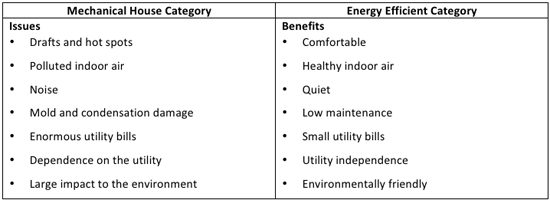In Part 1, we reviewed the issues with naming a new building technique as "passive".
Part 2
 Here we will explore 3 brand positions to highlight the benefits of "passive" building which relies on non-mechanical means to heat and cool a house. A particular housing development would emphasize only one. Three are offered since we want the efficient house to appeal to the most home buyers.
Here we will explore 3 brand positions to highlight the benefits of "passive" building which relies on non-mechanical means to heat and cool a house. A particular housing development would emphasize only one. Three are offered since we want the efficient house to appeal to the most home buyers.1. Operational Efficiency: Start saving this month
Operational efficiency appears to be a strong position, but how successful would Walmart be if its slogan was "Buy today and save in ten years?"
Rather than sell a difficult "investment" concept, a much stronger claim is to "stop wasting money on utility bills this month."
Note that the benefit is phrased to emphasize loss --- "stop wasting…" Behaviorists have found that losses create a stronger emotional appeal than savings. It is the "crying over spilt milk" syndrome.
For this strategy, the goal of marketing is to figure out how to adjust the product offering to make that claim valid. This may require:
- Defining financing options to realize positive cash flow in the first month. It wasn't until financing options became available that appliances such as refrigerators took off.
- Planning to allow for continued investment over the life of the product as energy costs increase and costs for energy efficiency decline. Such as adding more solar later.
- Focusing on energy savings features with the best returns.
2. Healthy Indoor Air: Accentuate a unique attribute
The air in our homes is often more polluted than outdoor air --- 2 to 5 times more polluted. With more than fifty million Americans suffering from allergies, asthma and other respiratory issues, the fresh filtered indoor air has the potential to bring relief.
To strengthen this strategy, marketing should also consider the other features of the home that complement the "clean air" concept such as low VOC paints and use of other materials that avoid outgassing.
Some may think that a single attribute such as health is insufficient to attract buyers. There are many successful brands that focused on the health / safety attributes:
- Car → Volvo
- Cleaning product → Clorox became a killer product by killing germs
- Bathing soap → Ivory 99 & 44/100 pure
3. High end: Fits your quality lifestyle
Most categories can support a luxury position. A luxury position is also consistent with current home market that ranges from starter homes to multi-million dollar villas.
Since there is more discretionary income, more features can be tried on this segment first.
The attributes of the passive house that will appeal to the luxury segment is emphasizing the utmost in comfort; including consistent indoor temperatures, fresh filtered air and quiet. With these benefits, the family can rejuvenate in their sanctuary.
The "artisanal" aspects of the home should be communicated as this is evidence of quality. For example, site considerations are used to work with nature and latest technology. Passive building respects traditional knowledge and skills that our grandparents used to build solid homes.
Often times a luxury buyer wants his purchase to be recognized by others. Examples are the distinctive Rolex wristband, the icon of a high-end car, and the designer handbag. Since energy efficiency is often hidden, creative marketing will be required to make it visible.
Green May Be Obvious, But Not Popular
The obvious choice to us engineers and green enthusiasts is to focus on the environmental and energy conservation benefits. As Joel Makower pointed out in his recent article Green Marketing Is Over, Let's Move On, consumers relate best to benefits that are personal or in this case closer to home.
There is an interesting challenge -- quality and green. This is all too often a counter-intuitive association for many consumers since they perceive green products as providing less performance, some inconvenience, and fewer options. Green may be better served to be inferred and handled in the details rather than the primary selling feature to move beyond the early adopters and attract the mass market.
Some may worry that the green consumer will overlook a message that does not hammer green. Green consumers are on the look-out for green. Operational efficiency and energy independence are all clear indicators that a product is likely to be green.
Time for a Marketing Course Correction
Passive construction is all about working with nature and science to build more effectively. This same principle can be used when marketing. Work with human nature and behavioral science to market more effectively.
Contact me to understand how to position your project for success



No comments:
Post a Comment